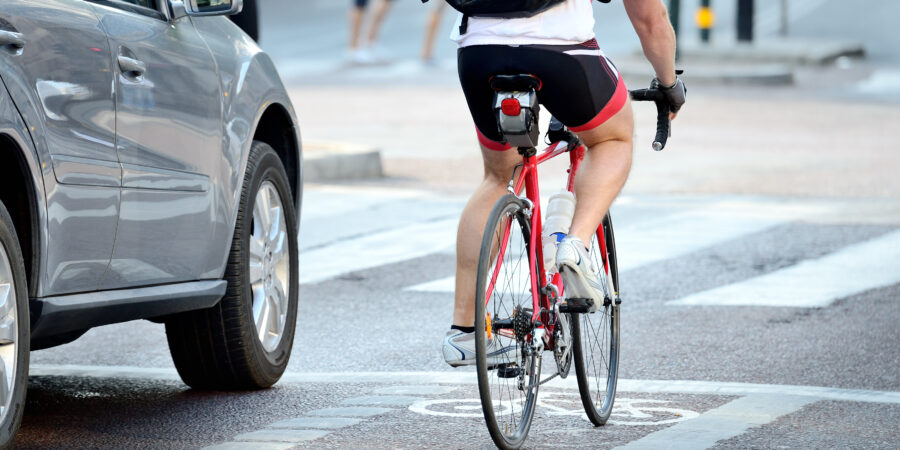Sharing the Road with Bicyclists
Bicycles have the same rights to the roadway as any other vehicle, and the same responsibilities apply to drivers too. However, the enormous differences in size and speed make the biker likely to suffer the most damage in a crash. An investigation by an accident attorney can help determine the cause of personal injury in a bicycle accident. A catastrophic injury that creates intolerable pain, an inability to work and lifestyle changes deserve legal representation and financial compensation.
Sharing Road Space and Obligations
Limited visibility and sound inside an automobile can prevent a driver from awareness of a biker, but no limitation can relieve the responsibility to share roads with cyclists. Common courtesy may offer the guidance that allows sharing of road space, but best practices for drivers and cyclists provide a safe environment for everyone on the road. Both can prepare for travel by knowing the rules that help keep everyone safe.
Accepting Biker Duties to Prevent Injury and Death
Almost every biker knows the importance of wearing a helmet. However, sizes vary among manufacturers, and a poorly fitting one cannot provide protection. A similar safety measure requires choosing the right size bike with brakes that work. Dressing appropriately means wearing bright clothes during the daytime and a reflective vest at night on a bike with lights and reflectors.
In addition, safety precautions require keeping both hands on the handlebars except for signaling. More than half of bicycle deaths occur in urban areas and during the summer months. Cyclists must observe the same traffic controls as vehicle drivers, and failing to yield the right of way causes the most fatalities. The courtesy extends to other bikers by not turning in front of them.
Defensive biking provides time to notice potential problems and avoid them. Riding with the traffic and obeying signs, signals and road markings can help prevent a car accident. In addition, planning to navigate around potholes or grates contributes to safe rides. Finally, avoiding the distractions of music or texting allows cyclists to drive predictably. Most importantly, it helps motorists know what to expect.
Submitting a Personal Injury Claim
The path to seeking compensation for a bicycle accident may seem overwhelming to someone with catastrophic injuries. However, some advice can help victims take the right steps.
- Create a Record
Make sure to get the contact information from witnesses, police officers and the other driver. A description of what happened to cause the car accident helps establish a claim for compensation. Photos of the scene provide valuable evidence. A written record must include expenses for medical bills, hospital charges, therapy, and lost wages.
- Get Medical Treatment
An official diagnosis proves the extent of injuries while providing treatment. Without a doctor’s opinion, a claim for damages may not produce desired results.
- File Immediately
An Accident Attorney can guide a bicycle accident victim through the legal process to obtain compensation for a personal injury. The chances of winning a claim get better by submitting it as soon as possible.
- Protect Your Privacy
Sharing information about a car accident on social media or talking to insurance adjusters can damage a claim.
Considering the Main Causes of Bicycle Accidents
The weight of passenger cars ranges from about 2,500 pounds for subcompacts and up to 3,000 more for SUVs. The force that they can deliver requires drivers to drive carefully to avoid hitting a cyclist. However, negligent behavior behind the wheel can make a driver responsible for car accident injuries.
Distracting Activities
Drivers who pay attention to texting, talking on the phone, dialing numbers, or using social media contribute to a leading cause of collisions with bicycles.
Going Too Fast
Stopping a heavy vehicle takes longer at high speeds, and drivers have less time to decide what to do to avoid a collision.
Failing to Stop
Drivers have the same obligation to observe traffic regulations as bikers do. Ignoring a red light or failing to halt at a stop sign can injure a biker who has the right of way. Many drivers choose to enter an intersection on a yellow light, increasing the risk of injuring bikers already there.
Driving Under the Influence
Alcohol and drugs can impair a driver’s ability to control a vehicle or respond promptly. While irresponsible behavior, impaired driving often causes collisions with cyclists.
Letting Fatigue Create Driving Risks
Drivers who want to get home after a long day at work can create risks of Catastrophic Injury to bikers. Likewise, staying out late with friends and starting a trip too early can reduce a driver’s alertness, resulting in accidents and injuries.
Failing to Yield
Drivers may not understand that they have the same obligation to obey traffic rules as bikers do. Oncoming traffic always has the right of way, and the rules apply to drivers of vehicles as well as bikes. Roundabouts create instances where the situation may occur. In addition, intersections with merging lanes can allow it to happen.
Weaving Back and Forth
Aggressive drivers may think they can save time by dodging the traffic in front of them, weaving to get ahead. The tactic rarely works to save time, but it can greatly increase the danger to cyclists. When cars proceed without weaving, it prevents risks to bikers. However, the practice allows almost no time for evasive maneuvers when it happens.
Changing Lanes
Drivers may decide to change lanes on a single occasion even when not weaving. It may seem that the idea to see whether a biker already occupies a lane does not occur. Unsafe lane changes can cause drivers to move a vehicle into a cyclist’s space without first checking.
Taking Advantage of Green Lights
The responsible way to approach an intersection requires a driver to pause and look for bikers or pedestrians. Even with a green light that allows drivers to proceed, responsible people consider the needs of others. A turn may occur right in front of a cyclist who has no way to avoid a crash and sustain injuries.
Crowding
While bikes have no vehicle tailgate, the process of following too closely unnerves bikers and poses a potential hazard. Drivers need to leave 3 feet of space between the car and the biker to avoid creating a dangerous situation. Failure to leave a buffer zone increases the likelihood of a driver hitting a cyclist.
Understanding Injuries
Inattention or careless and reckless behavior of drivers can cause life-changing consequences to bikers. In addition, speed and vehicle weight increase the damage that a negligent driver can cause. As a result, bikers can receive a Catastrophic Injury to different areas of the body:
Head
Helmets may lessen an injury to a biker, but they cannot prevent all scrapes or skull fractures. Early treatment for memory loss may help to prevent long-lasting complications. Brain injuries present a leading cause of death for injured cyclists. Even when not visible, a blow to the head can produce mood swings, emotional changes, impaired bodily functions, and mental alterations in addition to mood swings.
Face
Unfortunate consequences of injuries to the face include eye or vision damage, a broken nose and permanent scarring from road rash. In addition, the lasting effect of losing teeth or fracturing a jaw requires compensation for the unfair irresponsibility of others.
Body Trauma
A careless move by a driver can strike a cyclist’s back wheel and produce dire outcomes. Whiplash may occur and bracing for a fall can create a dislocated shoulder on landing and broken hands and wrists as well. In addition, bikers who get a glancing blow from a vehicle may receive a broken leg or soft-tissue injuries such as a torn ligament. Fractures may occur to the hands, wrists, legs and hips. When a biker injures a collarbone, deformity and lasting pain may ensue. The chest area may receive bruising or internal injuries that can cause potentially fatal damage.
Back
The force of a collision with a vehicle that throws a biker to the ground can cause damage to the spinal column. Herniated discs that may occur from severe neck or back trauma can lead to paralysis, a life-changing event that restricts the quality of life. Devastating consequences occur when paralysis makes mobility impossible or extremely difficult. In addition, the inability to use the arms and legs causes intolerable discomfort for car accident victims and emotional stress on families.
For whatever reason a crash occurs, an Accident Attorney can protect a biker’s right to compensation. A free consultation can provide guidance on options available to cyclists who have been injured in an accident. Contact our firm today for further legal assistance.


